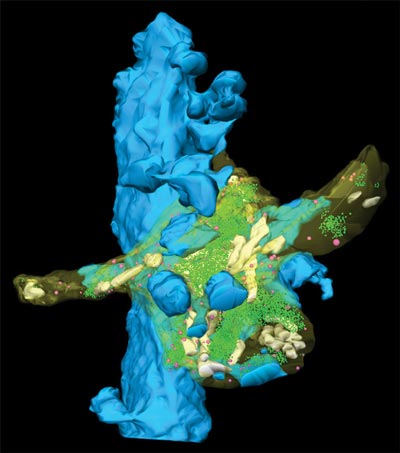February 6, 2014
Loose coupling between calcium channels and sensors: A key mechanism underlying synaptic plasticity
Science paper by IST Austria scientists reports first evidence for “microdomain” coupling at a mature central synapse and explores the implications for synaptic plasticity

In research published in this week’s online edition of Science (DOI: 10.1126/science.1244811), postdoc Nicholas Vyleta and Professor Peter Jonas of the Institute of Science and Technology Austria (IST Austria) uncover the existence of loose coupling between calcium channels and release sensors of exocytosis at a mature central synapse in the rodent brain. The researchers show that loose coupling provides a framework for presynaptic plasticity, a hallmark of synaptic signaling in hippocampal microcircuits.
Information transmission at the synapse between neurons is a highly complex, but at the same time very fast, series of events. When a voltage change, the so-called action potential, reaches the synaptic terminal in the presynaptic neuron, calcium flows through voltage-gated calcium channels into the presynaptic neuron. This influx leads to a rise in the intracellular calcium concentration. Calcium then binds to a calcium sensor in the presynaptic terminal, which in turn triggers the release of vesicles containing neurotransmitters into the synapse. The released neurotransmitter binds to postsynaptic receptors, leading to a response in the postsynaptic neuron. The coupling between calcium channels and sensors of exocytosis is key in determining the speed, timing and probability of synaptic transmission. Two forms of coupling occur in the brain: in tight, or „nanodomain“ coupling, channels and sensors are located very close to each other, with 10 to 20 nm distance, while in loose, or „microdomain“ coupling, channel and sensor are further apart, in the region of around 100 nm. Previous research suggests that loose coupling occurs in synapses during early development, while tight coupling is observed in the mature central nervous system. In their current paper, Vyleta and Jonas ask whether, given the advantages of tight coupling – including the speed, temporal precision, fidelity and energy efficiency of synaptic transmission – any synapse in the mature central nervous system makes use of loose coupling? And if it does so, what are the consequences for the function of synaptic transmission?
A specific synapse in the hippocampus, the mossy fiber synapse on CA3 pyramidal neurons, which is accessible to direct recording using the patch-clamp method and shows a high degree of plasticity, was the focus in this research. To investigate whether loose or tight coupling occurs in this synapse, Vyleta and Jonas made use of calcium chelators, which capture calcium ions on their way from the source to the sensor, to investigate the timescale and distance of coupling. If only the fast-acting chelator, BAPTA, can inhibit exocytosis and synaptic transmission, but the slow chelator EGTA cannot, tight coupling is at work, while in loose coupling, both fast and slow chelators can inhibit transmission. As both fast and slow chelators suppress transmission in the synapse under investigation, results suggest loose coupling between channels and sensors, with a mean coupling distance of around 75 nm.
Why does loose coupling, which is likely slower and has less fidelity than tight coupling, exist in the mossy fiber-pyramidal neuron synapse? Further results by Vyleta and Jonas show that due to loose coupling, fast endogenous calcium buffers in the synapse can act as a brake on transmission, controlling how likely the initial release of neurotransmitter is. Loose coupling provides the time frame for endogenous buffers to act on synaptic transmission. The saturation of endogenous buffers after repeated stimulation may also promote facilitation, the phenomenon in which impulses are more likely to generate action potentials when they closely follow a prior impulse.
The new findings challenge the view that loose coupling is a developmental phenomenon, demonstrating instead that coupling is regulated in a synapse-specific way. Loose coupling is predominantly used at dynamic and plastic synapses, both in the developing and the mature brain. Together with fast endogenous calcium buffers, loose channel-sensor coupling may provide the molecular framework for presynaptic plasticity, a hallmark of hippocampal neurons.



